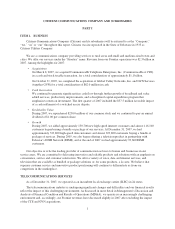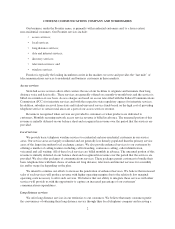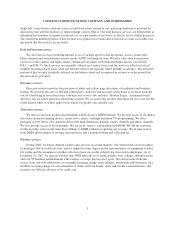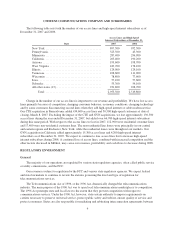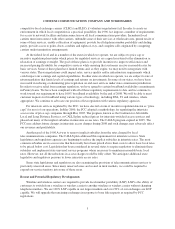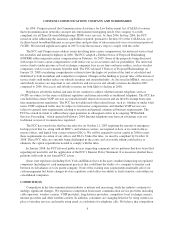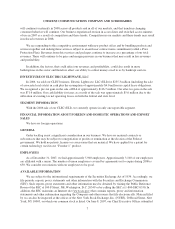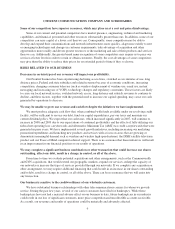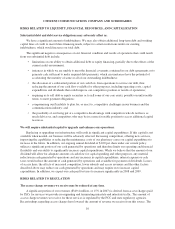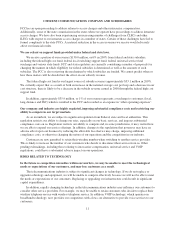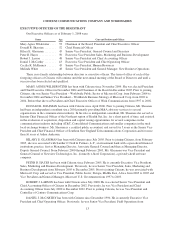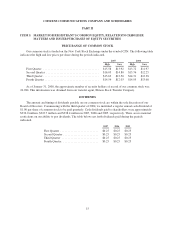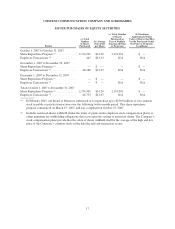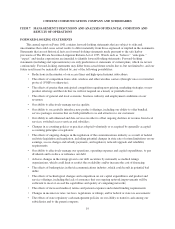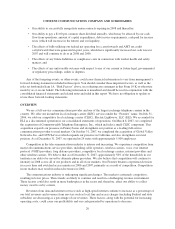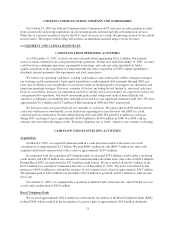Frontier Communications 2007 Annual Report Download - page 15
Download and view the complete annual report
Please find page 15 of the 2007 Frontier Communications annual report below. You can navigate through the pages in the report by either clicking on the pages listed below, or by using the keyword search tool below to find specific information within the annual report.CITIZENS COMMUNICATIONS COMPANY AND SUBSIDIARIES
FCC has an open proceeding to address reform to access charges and other intercarrier compensation.
Additionally, some of the state commissions in the states where we operate have proceedings to address intrastate
access charges. We have also been experiencing an increasing number of challenges from CLECs and other
ILECs with respect to our intrastate access charges in a number of states. Certain of those challenges have led to
formal complaints to the state PUCs. A material reduction in the access revenues we receive would adversely
affect our financial results.
We are reliant on support funds provided under federal and state laws.
We receive a portion of our revenue ($130.0 million, or 6% in 2007) from federal and state subsidies,
including the federal high cost fund, federal local switching support fund, federal universal service fund
surcharge and various state funds. FCC and state regulators are currently considering a number of proposals for
changing the manner in which eligibility for federal subsidies is determined as well as the amounts of such
subsidies. The FCC is also reviewing the mechanism by which subsidies are funded. We cannot predict when or
how these matters will be decided nor the effect on our subsidy revenue.
The federal high cost fund is our largest source of subsidy revenue (approximately $33.1 million in 2007).
We currently expect that as a result of both an increase in the national average cost per loop and a decrease in our
cost structure, there is likely to be a decrease in the subsidy revenue earned in 2008 through the federal high cost
support fund.
In addition, approximately $35.9 million, or 1% of our revenue represents a surcharge to customers (local,
long distance and IXC) which is remitted to the FCC and recorded as an expense in “other operating expenses”.
Our company and industry are highly regulated, imposing substantial compliance costs and restricting our
ability to compete in our target markets.
As an incumbent, we are subject to significant regulation from Federal, state and local authorities. This
regulation restricts our ability to change our rates, especially on our basic services, and imposes substantial
compliance costs on us. Regulation restricts our ability to compete and, in some jurisdictions, it may restrict how
we are able to expand our service offerings. In addition, changes to the regulations that govern us may have an
adverse effect upon our business by reducing the allowable fees that we may charge, imposing additional
compliance costs, or otherwise changing the nature of our operations and the competition in our industry.
Customers are now permitted to retain their wireline number when switching to another service provider.
This is likely to increase the number of our customers who decide to disconnect their service from us. Other
pending rulemakings, including those relating to intercarrier compensation, universal service and VOIP
regulations, could have a substantial adverse impact on our operations.
RISKS RELATED TO TECHNOLOGY
In the future as competition intensifies within our markets, we may be unable to meet the technological
needs or expectations of our customers, and may lose customers as a result.
The telecommunications industry is subject to significant changes in technology. If we do not replace or
upgrade technology and equipment, we will be unable to compete effectively because we will not be able to meet
the needs or expectations of our customers. Replacing or upgrading our infrastructure could result in significant
capital expenditures.
In addition, rapidly changing technology in the telecommunications industry may influence our customers to
consider other service providers. For example, we may be unable to retain customers who decide to replace their
wireline telephone service with wireless telephone service. In addition, VOIP technology, which operates on
broadband technology, now provides our competitors with a low-cost alternative to provide voice services to our
customers.
11


